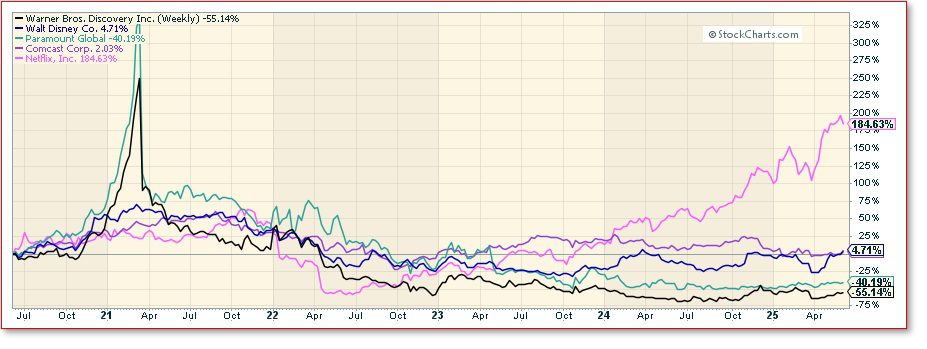Analyst Insights
Warner Bros. Discovery Plans Two-Way Split, Chasing Sharper Focus and Happier Stock Prices
Warner Bros. Discovery has announced plans to split into two publicly traded companies, dividing its streaming and studios assets from its traditional cable networks. The move is designed to address ongoing stock underperformance and streamline operations in response to industry shifts. The separation aligns with similar restructurings by other media giants and is expected to provide greater strategic clarity for investors. Leadership cites the need for specialization as a key driver, while analysts and markets have responded positively. The split will involve operational changes, regulatory review, and a renewed focus on both growth and efficiency.
On Monday, Warner Bros. Discovery (NASDAQ: WBD) reported it will carve itself into two companies, a maneuver it believes will rescue a slumping share price and clear up a strategy that has looked muddled since WarnerMedia and Discovery joined forces in 2022.
Under the proposal:
- A Streaming & Studios business will gather the crown-jewel content engines HBO, HBO Max, Warner Bros. Television, Warner Bros. Motion Picture Group, DC Studios, Warner Bros. Games, assorted studio tours, retail, and consumer-products units, plus the production lots in Burbank and Leavesden.
- A separate Global Networks company will run cable and free-to-air brands such as CNN, TNT Sports in the United States, Discovery Channel, a portfolio of top European broadcasters, and digital offshoots including Discovery+ and Bleacher Report.
David Zaslav keeps the group CEO title until the transaction closes, then moves entirely to Streaming & Studios.
Chief Financial Officer Gunnar Wiedenfels will become President and CEO of Global Networks while retaining his finance hat during the transition.
Corporate Backstory
The studio traces its artistic DNA to the 1920s, yet the corporate shell has shape-shifted for decades.
AOL bolted itself to Time Warner in 2001, AT&T (NYSE: T) bought Time Warner in 2018 and renamed it WarnerMedia, then spun that chunk into Discovery, Inc. three years ago, creating the current mash-up.
Integrating so many parts while cable TV slipped proved tougher than optimistic slide decks suggested, so management is trying a fresh cut.
What Sits Where After the Split
Streaming & Studios, Zaslav’s new home, keeps the flashy growth pieces. HBO Max already operates in 77 markets, with fresh launches penciled in for 2026, and management insists the combined studio engines are on track for at least $3 billion in annual adjusted EBITDA. The library includes films, series, and cartoons that cover a century of work and still sells well.
Global Networks becomes a cash-flow machine. The unit’s channels reach 1.1 billion unique viewers speaking 68 languages in roughly 200 countries. Margins are bigger than most rivals admit on earnings calls, partly because live news and sports still print money.
Wiedenfels plans to lean on that edge while hunting cost wins and pushing digital extensions of CNN, Discovery+, and B/R.
Transaction Mechanics
Management wants the breakup to qualify as tax-free under U.S. law. Lawyers are securing opinions and possibly a private letter ruling from the Internal Revenue Service to lock that down.
WBD also launched tender offers and consent solicitations to rework existing debt, funded short-term by a $17.5 billion bridge loan from JPMorgan Chase (NYSE: JPM). Each stand-alone business will pop out with its own, supposedly well-matched, capital structure.
Global Networks will keep up to a 20 percent stake in Streaming & Studios, monetizing that chunk later to speed deleveraging.
The companies expect to keep arm’s-length transition-service deals in place so day-to-day operations do not seize up on day one.
Roughly 35,000 employees must slot into one side or the other, and overlapping support teams almost certainly shrink. Projects straddling both camps, for example, a streaming documentary that uses CNN field crews, will need to be reviewed one by one.
Contract partners will sit through renegotiations as rights, distribution, and tech stacks get reassigned. Management repeats that there will be “minimal disruption,” though history says big splits rarely unfold so smoothly.
The target completion is mid-2026, but the deal still requires final board sign-off, regulatory approvals in multiple regions, tame credit markets, and no nasty tax surprises.
The Valuation Picture
Before the news, WBD traded around 0.63 times sales and 5.6 times free cash flow. By comparison, Netflix (NASDAQ: NFLX) sits near 7 times sales, and Disney, even with its own headaches, hovers above 1.5 times.
Monday’s announcement pushed WBD shares up roughly 12 percent intraday, a pop that shrank the valuation gap but did not erase it. Bulls argue narrow stories lure narrow-mandate investors. Bears think cable’s decline could swamp whatever multiple expansion the split delivers.
But carve-outs cost money, talent can bolt when companies change, and streaming competition, from Netflix, Disney+, Amazon’s Prime Video (NASDAQ: AMZN), Apple TV+ (NASDAQ: AAPL), is ready to pounce. If cable cash fades faster than forecasts, Global Networks could lose its dividend-like appeal.
Advertising dollars keep moving online, especially into digital video. Cord-cutting remains relentless in North America, and pay-TV declines are finally hitting parts of Europe that once looked resilient.
Interest rates are higher than they were when the 2022 merger closed, making “efficient capital allocation”, code for clean balance sheets, more urgent. A split, management argues, lines each business up with the world it actually faces.
Untangling shared technology, copyright libraries, billing systems, and even office leases can get ugly, fast. If either side blows its cost or revenue targets, the whole thesis wobbles. Keeping show-runners, on-air talent, and senior engineers happy during a two-year limbo period is another puzzle.
Why is Everyone Slicing Things Up
Investors, weary of “everything stores” that hide weak lines behind strong ones, prefer tidy boxes. So, media giants are dividing themselves faster than cable households are disappearing.
- The Walt Disney Company (NYSE: DIS) has floated unloading its linear networks.
- Comcast (NASDAQ: CMCSA) will spin the cable systems into a new outfit called Versant so it can concentrate on broadband and content.
- Paramount Global (NASDAQ: PARA) reportedly weighed selling pieces of its studio and Paramount+ service.
The 2027 Landscape
If the bets pay off, Streaming & Studios shows up in top-tier streaming share tables and pushes HBO Max well past the 100-million-subscriber mark. The unit would carry a tech-platform multiple, maybe something closer to Netflix than to old-school TV.
Global Networks, meanwhile, milks cash from live rights, trims costs, and hunts bolt-on buys of other legacy channels looking for a safe harbor.
If things go sideways, both could struggle. Streaming costs might outrun subscriber growth exactly as competition tightens, and cable cash could erode faster than new revenue arrives. Investors will watch leverage ratios, free-cash-flow conversion, and talent retention like hawks.
Either way, the deal hands each management team a clean scorecard, no more hiding behind aggregation. Whether that plan is genius or merely hopeful will show up, soon enough, in the numbers.
FIGURE 1: 5-Year Comparative Stock Chart







